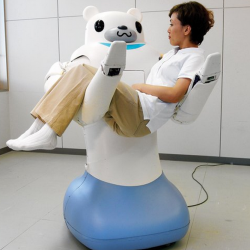
(photo: Tokyo Times)

(photo: Tokyo Times)
In Japan, a rapid increase in the elderly population is spurring an effort towards affordable robotic care. These robots would aid the elderly by performing daily tasks and lightening the load for caregivers. The Japanese government is helping the effort with 2.39 billion yen in the fiscal 2013 budget towards the development of nursing care robots. Twenty-four companies were selected to receive subsidies covering about two-thirds of the cost of developing nursing care robotic devices. The robots would be designated to help with daily activities including mobility and tracking.
Caregivers in Japan are in short supply and suffer from back pain due to constant lifting of patients, the Japanese government says. Robots can be “one of the few solutions” to this situation, says Akifumi Kitashima, deputy director of the industry ministry’s industrial machinery division in charge of the project.
Kitahima goes on to say that the robots would be inexpensive (about $1000 to $2000) and would be mass-marketed.
In effect, inter-generational families, once the rule in Japan, are a rarity. The young have migrated to the cities in search of employment, leaving their elderly family members alone. Finding trained caregivers is difficult and since foreigners are discouraged from seeking work in Japan as a matter of policy, the Japanese have turned to automation to solve the problem.
The number of people aged 65 or older in Japan is expected to increase by about 7.09 million over the next 15 years from 2010. The aim is to have a robot in every senior citizen’s home or one in three to four houses having at least one unit.
Currently, the government is leasing several robots free of charge to nursing homes. The Palro conversation robot plays games, sings and dances with the elderly. It understands spoken words and gives quizzes to stimulate conversation. (image below from HaloJepang) The seal-like Paro robot blinks its eyes and squeals when talked to. HAL, the exoskeleton suit, assists wearers to walk. There is also a self-cleaning bedside toilet and a small battery-powered trolley that helps the infirm walk by themselves.
Caregivers at the Fuyouen senior citizen’s home said that patients seem to accept the robots and interacted with them readily.
“I find them very effective”, says Akira Kobayashi, the head of Fuyouen. “I think people’s hearts, caring, and the warmth of physical contact can never be replaced by robots. But with many in the nursing care industry suffering from back pain, I am hoping that robots will be developed eventually so that they can ease such problems and enable them to work longer.”
Watch this video to see other ideas about robots and elderly care in Japan:
To read other posts in this exclusive ongoing series, please visit the Mobile Health Around the Globe main page. And if you have a Mobile Health Around the Globe story to tell, please post a comment below or email me at joan@socialmediatoday.com Thanks!
Sources:
http://www.halojepang.com/todays-japan/7185-robot
http://www.tokyotimes.com/2013/japans-robot-industry-for-elderly-encouraged-by-government/
http://www.economist.com/blogs/babbage/2013/05/automation-elderly